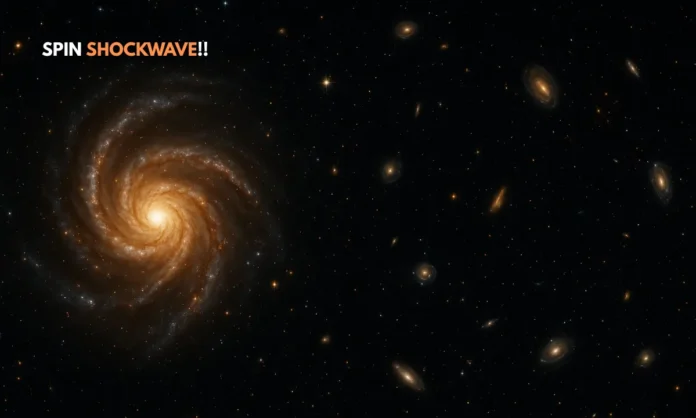Summary
- James Webb Space Telescope images of early galaxies reveal a surprising clockwise rotation trend, challenging the belief that galaxy spins are random.
- Some physicists are now reviving the radical theory that our entire universe could be contained within a colossal black hole.
- Despite potential measurement issues like Doppler distortion, the findings signal a deeper order in cosmic structure than previously assumed.
A Twist in the Cosmos: Galaxies Spinning Clockwise Defy Randomness
In a discovery that could shake the foundations of modern astrophysics, researchers at Kansas State University, using NASA’s James Webb Space Telescope, have identified a mysterious pattern in the rotation of ancient galaxies—one that suggests the universe may be far more organized than chaos-driven models have long proposed.
Out of 263 early galaxies observed—including some formed just 300 million years after the Big Bang—an astonishing 60% appeared to rotate clockwise. This orientation defies long-held expectations in cosmology, where galaxy spins were believed to be randomly distributed throughout the observable universe.
What could possibly align galaxies at the dawn of time in the same direction? That’s the billion-light-year question now prompting physicists to revisit some of the most radical theories in cosmology, including one that suggests our entire universe might exist inside a massive black hole.
A recent analysis of data from the James Webb telescope has blown the scientific minds: we may be living inside a giant rotating black hole. Yes, like in science fiction – only this is a very real hypothesis, called Schwarzschild cosmology.
— Black Hole (@konstructivizm) May 27, 2025
What gave scientists such thoughts?… pic.twitter.com/GXw8UuQO08
The Black Hole Hypothesis: A Universe Within a Singularity?
- The rotation trend has revived a controversial theory that proposes the universe is a holographic event horizon inside a giant black hole.
- If proven, it could radically alter our understanding of time, causality, gravity, and the birth of the universe.
- The model challenges the classical Big Bang interpretation, potentially replacing it with a gravitational collapse-based origin story.
The idea that we live inside a black hole is not new—but it’s been largely sidelined in favor of the Big Bang singularity and inflationary expansion models. Now, with Webb’s ultra-sensitive imaging uncovering signs of directional bias in galactic spin, proponents of the “universe-as-black-hole” theory are gaining new traction.
If these galaxies really did rotate in one dominant direction from the universe’s infancy, it could suggest that a boundary condition—possibly the event horizon of a parent black hole—set the stage for the entire cosmological system. That means our universe may not be an infinite, open expanse—but a finite space with curved, closed geometry defined by gravitational limits.
Such a theory could rewrite fundamental laws and resurrect ideas from Einstein’s general relativity, loop quantum gravity, and holographic principles once dismissed as elegant but unprovable.
Flawed Optics or Fundamental Physics? The Doppler Dilemma
- Some astrophysicists caution the spin pattern could be an illusion caused by the Doppler effect, which alters light frequencies based on motion.
- If not corrected, it could distort our understanding of which direction galaxies are really spinning.
- The research team acknowledges these limitations and may require parameter recalibration in the telescope’s data interpretation algorithms.
The study isn’t without skeptics. One of the key challenges is the Doppler effect, which can shift light spectra depending on whether a galaxy is moving toward or away from Earth—potentially causing false inferences of spin direction.
Moreover, Webb’s current imaging algorithms were not specifically optimised for detecting rotational orientation at this subtle level of analysis. The Kansas State researchers are now re-evaluating their observational filters, aiming to eliminate confirmation bias and assess whether the clockwise trend is genuinely physical or optically induced.
But even if partially flawed, the findings have already stirred the astrophysical community, proving once again that every answer Webb provides opens a dozen new questions.
What This Means for the Fate (and Birth) of the Universe
- A structured rotation pattern among early galaxies hints at cosmic order, not randomness.
- It challenges the second law of thermodynamics, which expects entropy to dominate in large systems.
- It also calls into question what came before the Big Bang, and whether time itself began inside another cosmic structure.
If confirmed, the notion that the universe is not randomly assembled but rather influenced by an ancient alignment or external boundary condition could ripple across disciplines—from quantum mechanics to string theory.
It could suggest that entropy, the arrow of time, and even causality itself are local phenomena, not universal truths.
Furthermore, if the black hole theory is validated, it forces physicists to consider the life cycle of universes—where black holes in one universe could spawn new ones, each with slightly different physical laws.
A Universe That Spins Together May Think Together
The discovery that galaxies born shortly after the Big Bang spin with an eerie, unified direction has left scientists both puzzled and inspired. Whether it signals a flaw in perception or a grand cosmic architecture, it proves that our understanding of the universe is far from complete.
With each revelation from the James Webb Space Telescope, we’re inching closer to cosmic truths that could reshape our place in existence. Maybe we’re not just watching the stars—we’re seeing the edges of a far deeper reality we’ve only begun to imagine.


